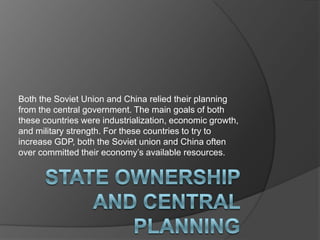Recommended
More Related Content
What's hot
What's hot (20)
Changing china's steel industry in the new normal (Byung-Kuk Ahn)

Changing china's steel industry in the new normal (Byung-Kuk Ahn)
Economic condition analysis of bangladesh......niloy.....

Economic condition analysis of bangladesh......niloy.....
Major economic indicators of Banladesh in mid 2015

Major economic indicators of Banladesh in mid 2015
Designing economic reforms - The case of North Korea and Vietnam 

Designing economic reforms - The case of North Korea and Vietnam
China Currency devaluation - International Business

China Currency devaluation - International Business
Viewers also liked
Viewers also liked (16)
More from phelpscivics
More from phelpscivics (16)
Blank.2.1.
- 1. Both the Soviet Union and China relied their planning from the central government. The main goals of both these countries were industrialization, economic growth, and military strength. For these countries to try to increase GDP, both the Soviet union and China often over committed their economy’s available resources.
- 2. Examples: They met these goals through investment in the investment in heavy industry and the military. Small-scale industries were scattered throughout the rural areas of China. Production of consumer goods often suffered, since planning priorities emphasized heavy industry, rural development, and the military.
- 3. My Perspective! In my opinion China and The Soviet Union shouldn’t over commit their economy’s available resources because their economy would drop extremely low and they wouldn’t be able to meet every planning target. Their planning priorities should be more than just heavy industry, rural development, and the military.
